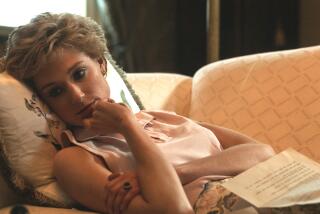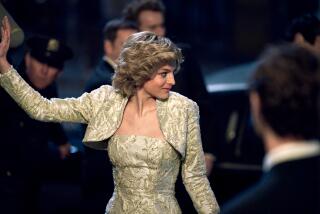Another Man Offers Companionship to a Lonely Princess
- Share via
Princess Diana strode through her spacious apartment in Kensington Palace, giving orders to those around her. She told Nanny Wallace that Harry would need looking after because she would be out late. She asked her lady-in-waiting, Anne Beckwith-Smith, to check through her speech for later that day, and then explained that her hairdresser should arrive by 10 o’clock at the latest.
She wore an old track suit and running shoes, her hair pushed up inside her baseball hat. Like any other young mother who had just been out jogging after a morning swim, Diana looked fit and healthy. She wore no makeup.
The phone rang and someone called out, “It’s for you, Ma’am,” and Diana, with a smile, disappeared into the quiet of the study to take the call. She seemed relaxed, with no hint of stress or strain. A young woman, a secretary needing to know about some appointments, walked into the room looking for the princess and was told she would return later.
Diana appeared friendly and firm, brimful of confidence. There was no doubt she was in total command of everything that went on in Kensington Palace. No one mentioned “HRH”--the prince of Wales, her husband of 10 years and heir to the throne.
One hundred miles away in Gloucestershire, Prince Charles was at his own home, Highgrove. That evening he sat in the drawing room with his close friend of many years, Camilla Parker Bowles. Having had dinner together, they chatted and listened to classical music. Charles seemed relaxed and happy, and Camilla appeared very much at home in the prince’s house.
It is January, 1992.
Just two months earlier, near the time of his 43rd birthday, the prince told his most trusted friends that for all intents and purposes his marriage to Princess Diana was “over.” Though by royal tradition there could hardly be a divorce, the famed couple were “separated,” in reality, if not in law, living separate lives, at separate tables, in separate beds.
For some time his friends had seen the writing on the wall for Charles and Diana. They knew there was little, or nothing, they could do to save the marriage.
The rumors that have emerged during the past 10 years about their stormy relationship are basically accurate. The tales of Diana, distraught, unhappy and alone in her world of palaces and privileges, were, to a great extent, true. The fearful shouting matches--including Diana’s use of four-letter epithets--which took place in private did occur. Charles’ jealousy of Diana’s love affair with the British people confused and consumed him, and his decision to live a life separate from her and the children began to take shape in the late 1980s, when he felt there was very little, if anything, left between him and Diana.
The papering over of their separation is part of the British royal way of life. Charles and Diana are living a sham, but the queen is adamant that, above all else, all members of what she likes to calls “The Firm” are expected to be the embodiment of stability, to uphold the finer virtues of family life, the home and responsible parenthood, if only for appearance’s sake. The queen believes in it implicitly, especially when one-third of all marriages in Britain end in divorce, and one-quarter of all live births are to young women out of wedlock.
The state of Charles and Diana’s marriage was one of the prime reasons the queen clearly indicated in her Christmas broadcast of 1991 that she intended to continue as monarch until her death. With just 26 words the queen, then age 66, put a halt to the mounting speculation that she might abdicate. At the same time, she put a damper on the hopes of those who would like Charles to become king before he is in his dotage.
The queen knows that she can totally trust Charles to uphold the monarchy and carry out his duties no matter what happens in his private life. But she is not sure she can trust Diana. The queen would be distraught if she should abdicate in favor of Charles and then watch helplessly as Charles and Diana fight openly while nominally a bastion of family life in Britain.
What concerns the queen even more is the possibility that Diana might take rebellion further and announce publicly that she is living apart from her husband, in exactly the same way Diana’s mother, Frances, announced in 1967 that she was living apart from her husband, Viscount Johnny Althorp (later Earl Spencer).
Such an announcement would be an unmitigated catastrophe for the monarchy. It would plunge the country into a constitutional crisis that would pose the greatest threat to the future of the monarchy since the abdication of King Edward VIII in December of 1936. For if Diana did formalize their present private separation, Charles would find it all but impossible to take the religious vows at his coronation as king and head of the Church of England, thereby precluding his accession to the throne.
If those events did indeed unfold, then the throne would pass directly to young Prince William, who would become monarch on the death, or abdication, of the queen. And if the queen should die before William reached the age of 21, then Charles would act as regent, ruling in the name of his son until he reached his majority.
The queen’s fears that Diana might increasingly be seen and rumored about with eligible men has become a full reality. In fact, her two boys have built up a relationship with one of Diana’s close friends, the handsome Life Guard officer who commanded a tank squadron in the 1991 Gulf War, Maj. James Hewitt, 34.
Hewitt has not only helped teach the boys to ride, he has spent many hours helping Diana overcome her nervousness on horseback. (Ever since she had a bad fall from her pony in childhood, she has disliked riding.) Despite efforts by Charles, the queen and others who have tried to help Diana, Hewitt is in fact the only person who has succeeded in giving Diana the confidence to enjoy riding.
Both William and Harry think a lot of James. Once when James fell while playing polo, William was the first person on the scene. The youngster ran onto the pitch shouting: “James, James! Are you all right? Did you hurt yourself?”
At the time, Hewitt was stationed at Combermere Barracks near Windsor, and Diana used to drive over for riding lessons with him at the barracks. At first Jamie gave her his own sure-footed mount, Gruden 11, to help ease her nervousness. Then the two of them would go out alone together for rides through romantic Windsor Great Park. But the more Diana saw of Jamie, the more she preferred going to Windsor to ride. Sometimes Diana would even leave her sons at the barracks to mess about in the tanks while she went off with Jamie for an hour’s ride.
Throughout 1989 and 1990, Diana saw more of James. They were constantly on the phone to each other. They went out together in London, to parties, to supper and to restaurants, as Diana sought for company in her loneliness. She gave him presents, including a diamond-studded tiepin and a gold-and-silver alarm clock from the queen’s jewelers, Asprey. The gifts would arrive with a handwritten note from Diana, signed “Dibbs,” James’ pet name for the princess. During the Gulf War, Diana would wake as early as 5 a.m. to hear the latest television reports of the fighting, fearful that anything should have happened to “my James.”
Diana first met Jamie when she presented a silver cup to him as captain of the victorious polo team in the summer of 1989. At the time, he had been going steady for four years with a girl who bears an uncanny resemblance to Diana, a beautiful and wealthy heiress, Emma Stewardson, a member of the famous Losely ice cream family.
Emma spoke about Jamie’s affection for Diana, claiming she lost her man to a princess: “How could I compete with the princess of Wales? Diana is beautiful, fabulously rich, and she lives in a completely different world from mine.
“Jamie told me all about it one evening in the summer of 1990. We went to a pub near my home, a cottage not far from Diana’s country home, Highgrove. He told me that Diana had become a friend of his, a very close friend. He told me he was infatuated with her but realized she was married and nothing could come of such a relationship. He seemed to think it wouldn’t damage our relationship. Even during the Gulf War he would send me wonderful love letters.
“I think Jamie is infatuated by the princess. I feel sure he was carried away by the glamour of the princess’ world. So I wrote to Jamie’s father, warning him that Jamie seemed to be getting carried away by his infatuation, but he told me that I should mind my own bloody business. I still hope that we can get together when this is over. He has always made me go weak at the knees.”
Those who see the copper-haired major and Diana together say there is a definite chemistry between the two. Diana was attracted by the way he always blushed when they met, something she did when she was younger.
James Hewitt, however, is seen by the general public as a dashing, ice-cool tank commander who distinguished himself with his leadership and tactics during the Gulf battles.
A member of the royal family commented, “There is indeed a special relationship between the two of them. And they do see a lot of each other.”
WEDNESDAY: How the fairy-tale marriage unraveled.
More to Read
Sign up for Essential California
The most important California stories and recommendations in your inbox every morning.
You may occasionally receive promotional content from the Los Angeles Times.










